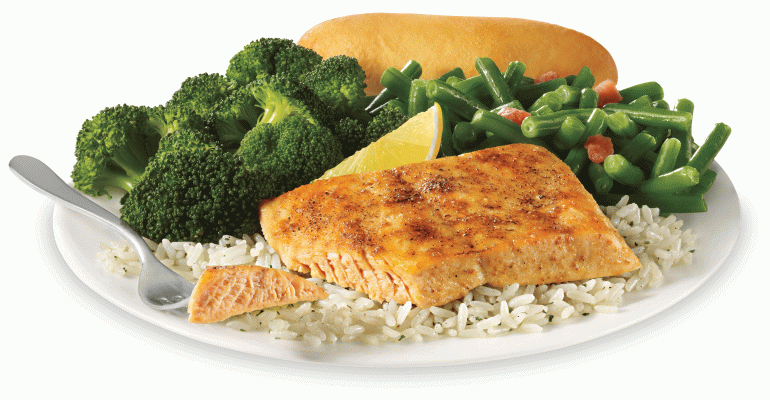In January, Bay Area-based Pacific Catch West Coast Fish House hired Jennifer Bushman as its first director of sustainability. The restaurant then audited its entire menu and overhauled its sourcing systems to ensure that all of the seafood it serves are out of the so-called “red zone” of fish to avoid.
“Pacific Catch, for the most part, was largely sustainable all along, but that hadn't been conveyed,” Bushman said. “It’s a huge commitment. Conveying provenance to the guests creates loyalty and a greater sense of trust.”
Five months after Bushman was hired, the menu at Pacific Catch’s eight locations is entirely out of the red, featuring a balance of wild-caught and sustainably raised seafood. There’s also a new website and social media designed to articulate to the restaurant’s commitment.

Alaska sablefish (black cod) with puttanesca sauce and olive crumb at Kincaid Grill in Anchorage.
Pacific Catch is just one of a growing number of operators and chefs paying attention to and taking action around sustainability.
According to the National Restaurant Association’s “The State of Restaurant Sustainability 2018” report, environmental sustainability is a top menu trend this year.
While both wild-caught and farm-raised fish can be sustainable, consumers and operators show a strong preference for wild-caught seafood, according to Datassential’s 2017 Seafood Keynote. Fifty-three percent of customers prefer wild-caught seafood and 42 percent of operators prefer wild-caught.
At 520-unit Captain D’s, the core and top-selling item is batter-dipped fish made with wild-caught, sustainable pollock. Wild Alaskan salmon from the chain’s grilled menu is another customer favorite.
“Not all of our guests ask about these topics currently, but they credit us for great taste, quality and value of our seafood,” said Jason Henderson, Captain D’s vice president of product innovation. “Wild, sustainable fish remain a key part of our 50-year-old brand’s success.”
Chef Lauro Romero built his entire menu at the newly opened King Tide Fish and Shell on the waterfront in Portland, Ore., around sustainable seafood. Among his signature sustainable seafood options is wild line-caught Oregon rockfish, which he offers three ways on his menu: as part of his signature fish n’ chips, as a ceviche and an entree.
“It used to be that trying to achieve sustainability was more expensive,” Romero said. “Now it’s more affordable and people are asking for it.”
At Limones, a Mexican and Californian cuisine restaurant in Asheville, N.C., the current menu features wild-caught sustainable fish, such as tuna, snapper, halibut and scallops.
"We generally have a hefty seafood selection on our menu, and we're always asked if we serve wild-caught or sustainable seafood,” said manager Karina Barnes. “Our local supplier advises us as to what is in season and fresh, and we build our menu accordingly.”
While more restaurants may be serving sustainable seafood, few are calling it out on menus. Only 1 percent of seafood menus directly mention sustainability, according to Datassential.
Chef Drew Johnson of Kincaid Grill in Anchorage, Alaska, calls out local seafood on his menu, such as the Alaska sablefish (black cod) with puttanesca sauce and olive crumb, and Alaska kodiak scallops with spaghetti squash and red pepper gel.
“We advertise local seafood on our menu and we are lucky that Alaskans take pride in sustainability,” Johnson said. “As for the newcomers or tourists, our extremely knowledgeable and attentive servers provide insight that the guest may not already have.”
While the menu at Roe Seafood in Long Beach, Calif., features about 80 percent wild-caught, local and sustainable seafood, owner and executive chef Arthur Gonzalez doesn’t call it out on the menu.
“I’m not a huge preacher of labeling seafood dishes as such on my menu because the word ‘sustainable’ is thrown around too loosely and often loses its meaning,” Gonzalez said.
With the recent announcement that Red Lobster, the world’s largest seafood chain, has become an official Seafood Watch partner and has committed to offering only Seafood Watch recommended options by 2025, serving or calling out sustainable seafood may soon no longer be a choice, but an industry standard.
In the words of Bushman, who came to Pacific Catch with decades of experience as a seafood sustainability consultant, “If you want to be in business in 20 years, you’d better be on board.”





